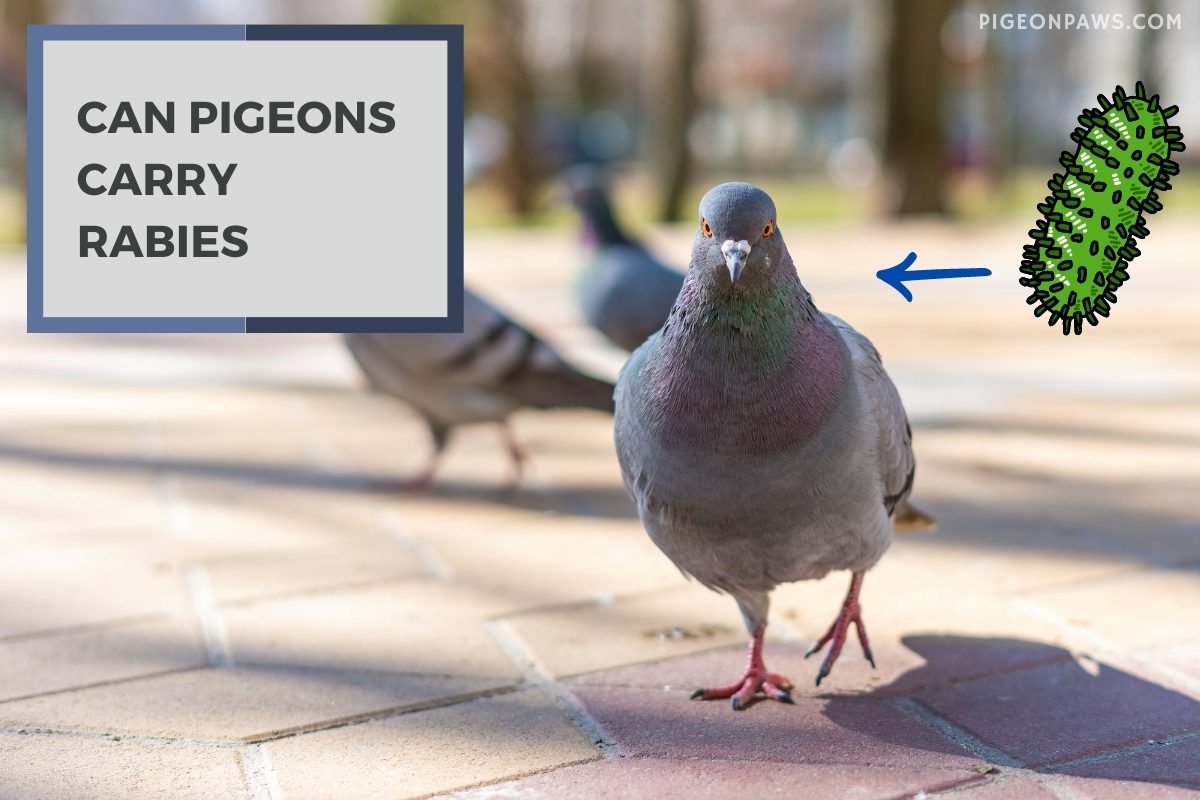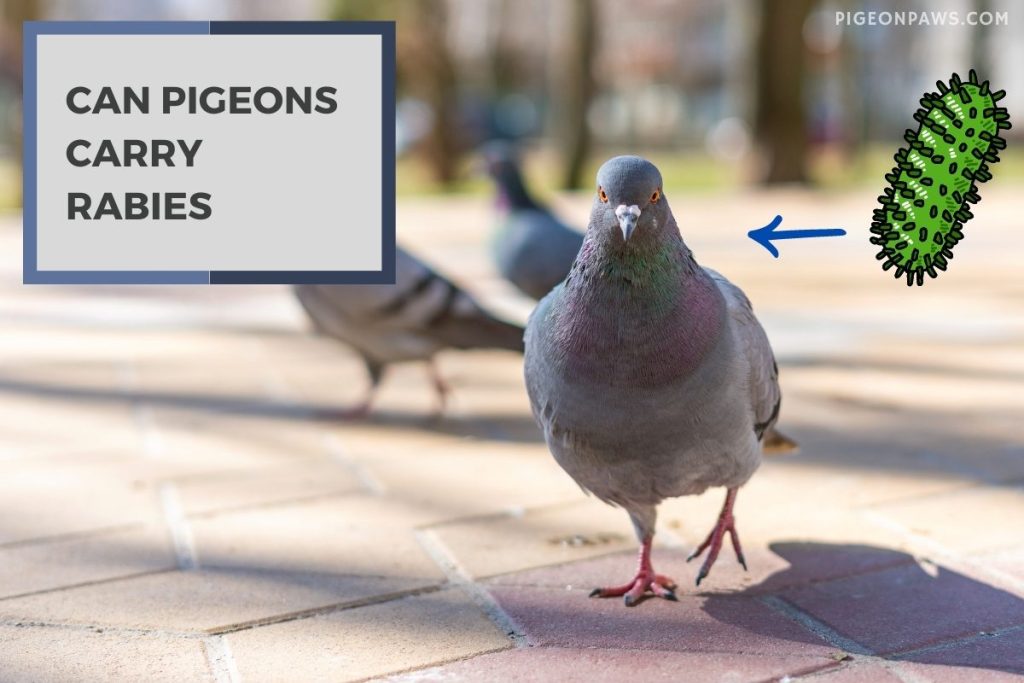Can Pigeons Carry Rabies? Fact or Fiction?

Pigeons are ubiquitous birds that can be found in most cities and towns around the world. But, there are some concerns about their ability to carry diseases, particularly rabies. Can pigeons carry rabies? This is a valid concern for many people, especially those who regularly come in close contact with pigeons.
No, pigeons cannot carry rabies. And all confirm that birds, including pigeons, cannot carry rabies because the disease only spreads through mammals.
In this article, I’ll dive into the subject of pigeons and rabies and explore the reasons why pigeons cannot carry the virus. I’ll also discuss other diseases that pigeons may carry and what precautions you can take to stay safe when interacting with these birds. So keep reading!

Does Pegion Carry Rabies?
Pigeons are a common sight in cities and urban areas. But the question remains: can they carry rabies? Rabies is a deadly viral disease affecting mammals’ nervous systems, including humans. It is usually spread through the bite of an infected animal.
Contrary to popular belief, pigeons are not known to contract or carry the rabies virus. According to the Centers for Disease Control and Prevention (CDC), only mammals, such as dogs, cats, bats, and raccoons, are known to contract and transmit rabies to humans.
While it is extremely unlikely for a pigeon to carry rabies, it is still essential to be cautious around them as they can carry other diseases that can be transmitted to humans.
For example, pigeons can carry diseases like histoplasmosis and cryptococcosis, which can be contracted by inhaling airborne fungal spores from bird droppings.
What Are The Other Diseases Pigeons Can Carry?
Pigeons are common urban birds and are often seen in cities and towns around the world. While they are not known to carry rabies, they can carry other diseases that can be harmful to humans and animals. In this section, we’ll explore some of the other diseases pigeons can carry.
Salmonella
Pigeons are known to carry Salmonella bacteria, which can cause food poisoning in humans if ingested. This bacteria is commonly found in the fecal matter of pigeons and can spread to water and food sources, resulting in potential health risks.
Salmonella has been known to cause abdominal cramping, fever, and diarrhea in infected individuals, which can lead to dehydration and other complications if not treated immediately.
E. coli
In addition to other animals, pigeons’ intestines frequently contain the bacteria E. coli. Similar to Salmonella, it can be hazardous to people because eating it can result in food poisoning.
It is crucial to be aware of the risks and use good hygiene when handling food because the bacteria can be spread to people through contaminated food and water sources.
As it can cause potentially serious illness and, in some cases, even death, it is best to avoid consuming any food or water that may be contaminated with the bacteria.
Histoplasmosis
This is a fungal infection caused by the inhalation of the spores of a fungus known as Histoplasma capsulatum. This fungus is commonly found in soil and bird droppings, particularly those of pigeons.
It is estimated that over 90% of the United States population has been exposed to the Histoplasma capsulatum fungus. However, in most cases, it does not cause any symptoms.
When symptoms are present, they often mimic those of a respiratory infection and may include fever, chest pain, coughing, and shortness of breath. In people with compromised immune systems, it can be more severe and may even be fatal in some cases.
Ornithosis
Ornithosis, also known as psittacosis, is an infectious disease caused by the bacterium Chlamydia psittaci. People are generally exposed to the disease by breathing in dust or debris contaminated with bacteria from the droppings of birds, primarily pigeons.
Symptoms of ornithosis are similar to those of the flu and may include fever, headache, chills, muscle aches, and a dry cough. In more severe cases, it can cause chest pain, confusion, and difficulty breathing.
Do Homing Pigeons Have a Higher Risk of Getting Lost if They Carry Rabies?
While homing pigeons are renowned for their amazing navigation abilities, the notion that carrying rabies increases their risk of getting lost is a mere myth. A study on homing pigeons’ navigation debunked this misconception, highlighting that their exceptional homing skills remain unaffected by the presence of rabies. These resilient creatures effortlessly find their way back, regardless of any ailment they might carry.
What to Do If You Come in Contact with A Rabid Animal?
Well, it’s a situation we all hope we never have to face, but it’s important to know what to do if you come in contact with a rabid animal. Believe it or not, rabies is still a genuine problem in many parts of the world, and it can be a severe and even deadly disease. So what should you do if you come in contact with a rabid animal? Let’s dive in and find out.
Immediate Action
If you have been bitten, scratched, or have had saliva from a potentially rabid animal get into your eyes, nose, mouth, or a fresh open wound, wash the affected area with soap and water for at least 15 minutes. Seek medical attention immediately, as post-exposure treatment may be necessary.
Reporting The Incident
Report the incident to the local health department or animal control to help monitor the spread of rabies in the area. Provide detailed information about the animal’s appearance, behavior, and location.
Preventing Future Incidents
Get your pets regularly vaccinated to protect them from rabies. Avoid attracting wildlife to your property by securing trash, pet food, and bird feeders. Do not approach or touch wild animals, even if they appear friendly.
Conclusion
Pigeons are unlikely to carry rabies, as the virus is typically transmitted through the saliva or nervous tissues of infected mammals such as raccoons, skunks, bats, and foxes.
But, pigeons can carry other diseases such as histoplasmosis, Salmonella, and ornithosis. If you come in contact with a potentially rabid animal, it is essential to wash the affected area thoroughly with soap and water and seek medical attention immediately.
By understanding the risks and taking the necessary precautions, you can help protect yourself and your community from spreading disease.

